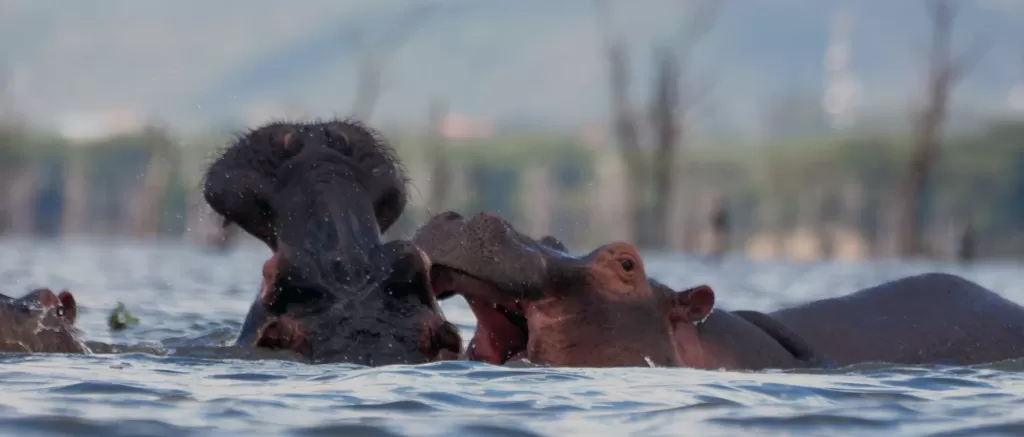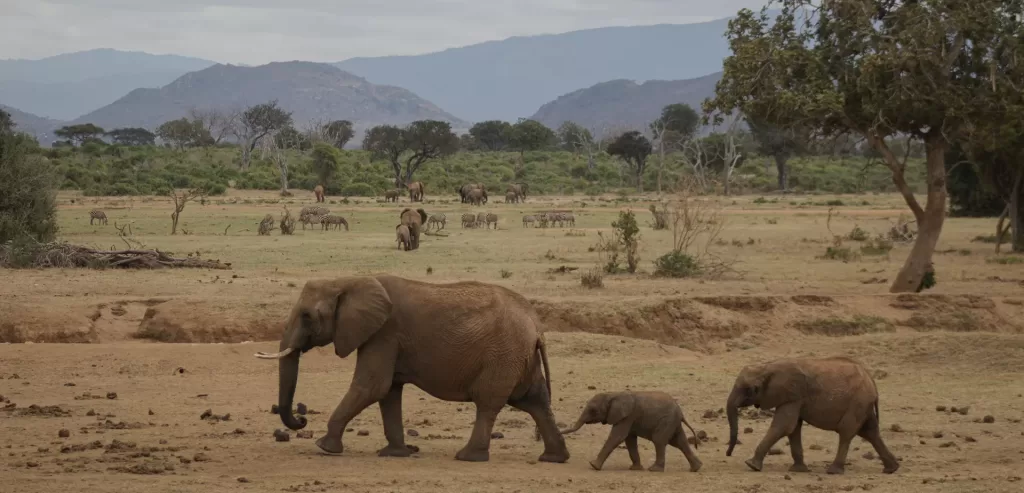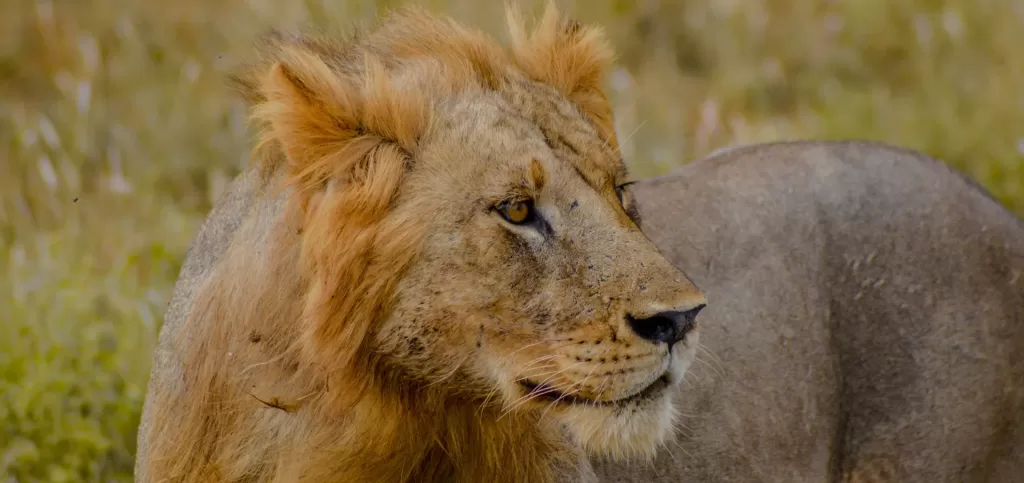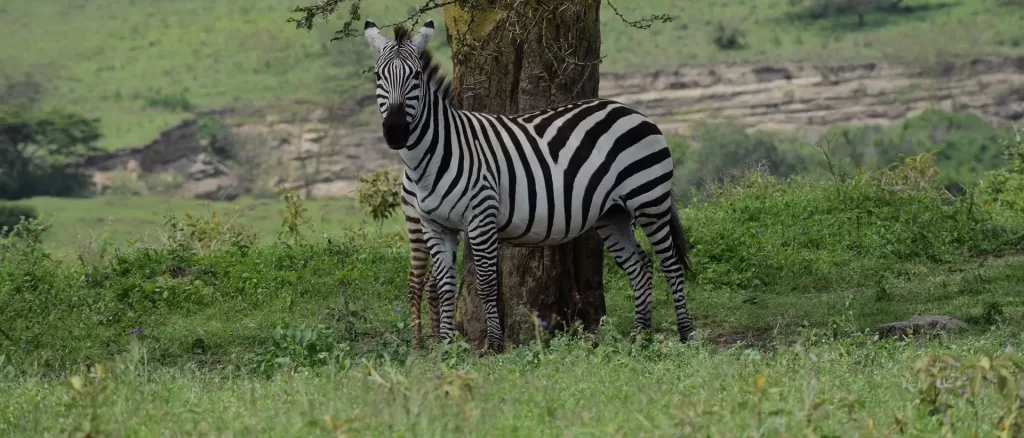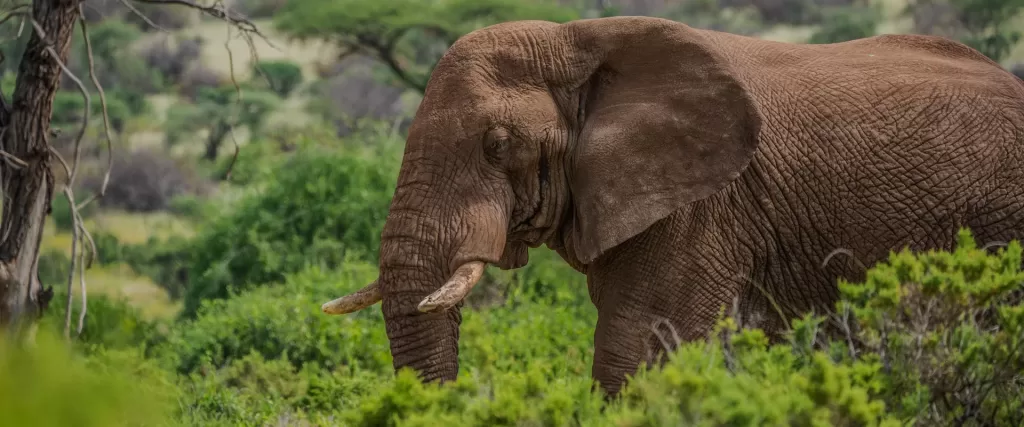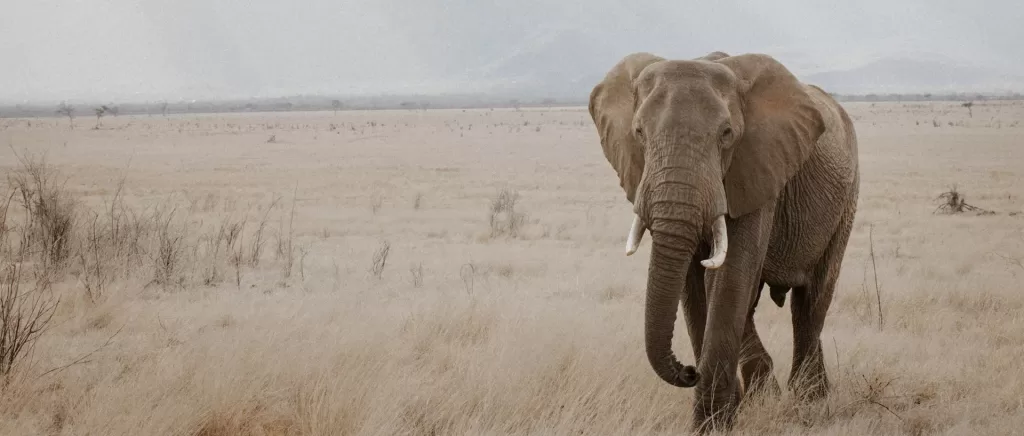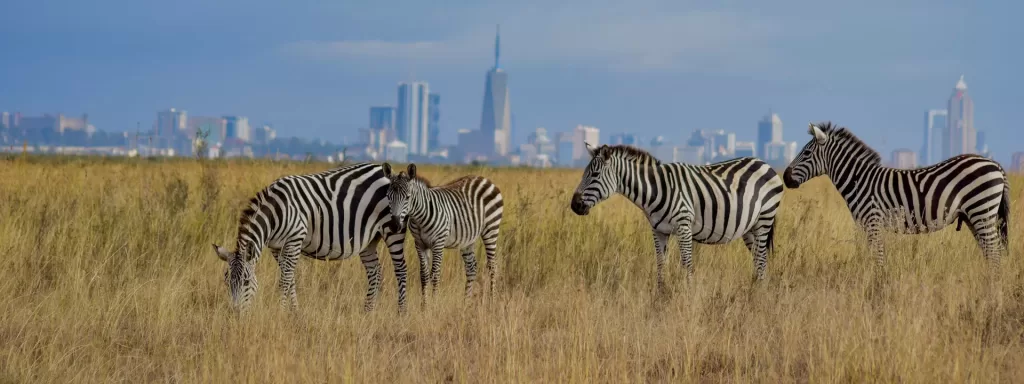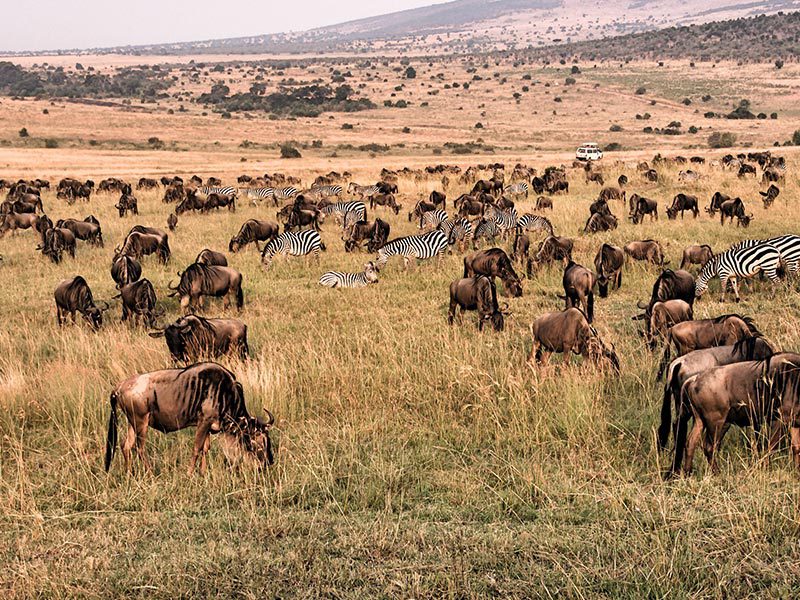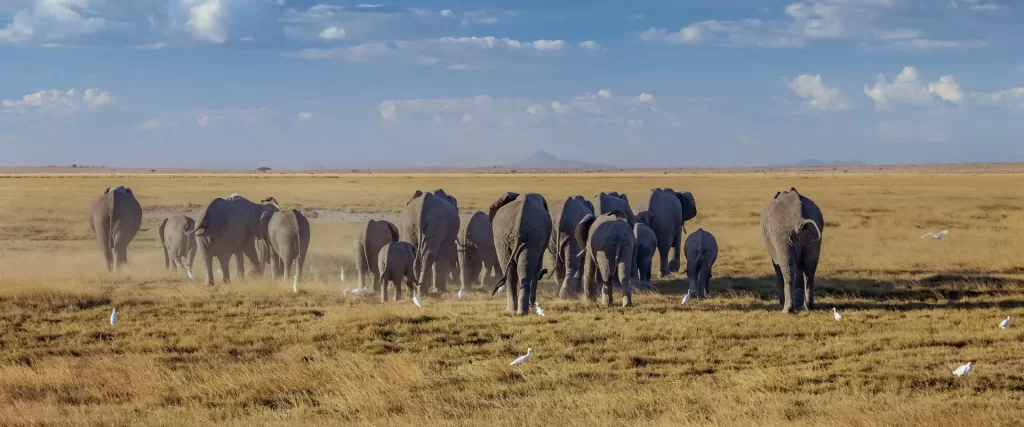Aberdare National Park
Aberdare National Park, situated at the edge of the Aberdare Mountain range in Kenya, was established to safeguard the slopes and moorlands of this majestic mountain.
Encompassing an area of 767 square kilometers, it spans altitudes ranging from 1,829 meters to 4,001 meters above sea level, boasting the impressive peaks of Kinangop (3,906 meters/12,814 feet) and Ol Donyo Lesatima (3,999 meters/13,123 feet).
Aberdare National Park consists of two distinct ecosystems. The Salient features lush rainforests and hills adorned with towering waterfalls, with mountain elevations ranging from 2,000 meters (6,600 feet) to 4,000 meters (13,000 feet).
Meanwhile, the Kinangop Plateau presents a windswept expanse of rugged moors, dotted with hills, bogs, and pristine mountain streams. The misty atmosphere that blankets the moors adds to their enigmatic allure.
Renowned for its dramatic 300-meter-high waterfalls, challenging mountainous terrain, mist-shrouded tropical forests, bamboo groves, and expansive moorlands.
It boasts the second-largest population of Black Rhinos in Kenya, while sightings are frequent of Spotted Hyenas, Bush Pigs, Waterbuck, Jackals, eland, and occasionally the elusive Black Leopard.
Aberdare National Park has a cool, mist-laden environment that provides a haven for a plethora of bird species, with over 290 recorded, including the endangered Aberdare cisticola, as well as raptors like Buzzards, Hawks, and the African Crown Eagle.
Furthermore, butterflies flourish in abundance within the park’s varied habitats, from the lush forests to the windswept moorlands.
Things to do and see at Aberdare National Park.
Walking Safaris and Hiking
The stunning forests and moorlands, along with a refreshing climate, glistening streams, and diverse wildlife, create the perfect setting for nature enthusiasts and hikers in Aberdare National Park.
The Aberdare mountain ranges, integral to this National Park, establish it as a haven for hikers, offering a blend of mountainous and hilly terrains ideal for exploration.
Visitors can embark on hikes to the Table Mountains, Twin or Elephant Hills, or venture across magnificent waterfalls, all while reveling in breathtaking scenery and encounters with wildlife.
Game Safaris (Day & Night Game drives)
Explore this amazing Aberdare National Park with cool temperatures on Game drives both during day or night and get to encounter its diverse wildlife species like the big 5 animals, and several wild cats including the unique rare species.
Game drives can be done in three sessions, from 6:30 am to 10:30 am this is the best time to see animals actively looking for food and some going back from their hideout.
The Evening game drive in Aberdare National Park is from 2:00 pm to 6:00 pm time to see animals under the tree resting, a huge number of species can be seen on water banks linking for water.
Night game starts at 6:30 pm to 7:30 pm best time to see nocturnal animals like Bush babies, Leopards, and Lions.
Explore the Waterfalls
Aberdare National Park boasts an impressive array of famous waterfalls. Gura waterfall stands out with a dramatic drop of 300 meters (984 feet), making it the tallest waterfall in Kenya.
Additionally, visitors can explore the breathtaking Karura, Chania, and Maraqua Falls. A trip to Karuru and Chaina waterfalls promises an exhilarating adventure, complete with intimate nature walks through the moorlands.
As you traverse these trails, you’ll be treated to stunning views of the majestic Lesatima and Kinangop peaks.
Experience Ol Pejeta Conservancy
Nestled amidst the picturesque snow-capped Mount Kenya and the foothills of the Aberdares Ranges, Ol Pejeta Conservancy boasts a rich tapestry of wildlife, including the renowned Big 5 (Lion, Buffalo, Leopard, Elephant, and the critically endangered Rhino), along with the captivating presence of non-indigenous chimpanzees.
Immersing oneself in the breathtaking vistas and diverse wildlife that roam the expansive plains of Ol Pejeta guarantees an unforgettable safari adventure.
Within the conservancy, visitors can explore the Chimpanzee Sanctuary, where they can encounter remarkable residents such as Baraka, the blind Rhino, and the last two remaining northern white rhinos.
The reserve serves as a sanctuary for 2 endangered northern White Rhinos, 73 endangered Black rhinos, and more than 40 Chimpanzees, alongside an array of other iconic species including Lions, Elephants, Buffalos, and Leopards.
Additionally, the landscape is adorned with Giraffe, Grevy Zebra, Ostrich, Cheetah, Thomson’s Gazelle, Grant’s Gazelle, Oryx, Black-Back Jackals, Waterbuck, Baboons, eland, and a myriad of bird species, creating a vibrant mosaic of biodiversity.
Visit Sweetwaters Game Reserve
Traveler can still engage in chimpanzee trekking at Ol Pejeta Conservancy in Nanyuki which take a 1 to 2 hours drive to reach there.
This activity can be done in the morning or afternoon time as you learn more about the Chimpanzees and their way of life which includes grooming, playing, feeding, nesting, and de-nesting among others.
Trout Fishing
This can be done on various rivers like the icy cold guru, Karuru, or Chaina flowing rivers just below the waterfalls in the moorland and other numerous fishing spots in the park which have unique features including more waterfalls, you can also do cave fishing as well as get to see lots of wildlife. The park is known for its bountiful stock of brown and rainbow trout.
Bird watching
The Aberdare National Park showcases an impressive array of bird species, boasting five out of the eight species within its Endemic Bird Area, as well as 53 out of the 70 bird species from the Afrotropical Highlands biome found in Kenya.
For bird enthusiasts, the forests and moorlands of Aberdare National Park offer a captivating experience, with a documented count of over 290 species.
Exploring the park, birding enthusiasts can delve into three distinct regions. The Kikuyi escarpment forest, nestled on the southern side of Aberdare Forest, provides a unique habitat.
Venturing into the Mukurweini valley, located in the southeast of the Aberdares, presents excellent chances to spot the elusive Hinde’s babbler.
Lastly, the Kinangop Grasslands within Aberdare serve as prime viewing spots for Kenya’s national endemics, such as the distinct sharper long claw.
Noteworthy species like the Hartlaub’s turaco and Near Endemics like the Jackson’s Francolin and Sharpe’s Longclaw should be sought after.
The Aberdare cisticola, endemic to the region and commonly sighted at higher altitudes, stands as another remarkable find. Furthermore, the scarlet-tufted malachite sunbird frequents the mountain peaks.
The park’s diverse forest bird species, including Sunbirds, Goshawks, Fish eagles, and the Aberdare cisticola, contribute to the allure of birdwatching in this picturesque national park.
Climbing Mt. Satima via Dragons Teeth and Mount Kinangop.
This scenic hike towards the highest summit in Aberdare National Park starts 12km beyond the Rhino gate. During the drive up, it is possible to spot Zebra, Waterbucks, Warthogs, and other wildlife.
The hike towards Satima summit at 4000m altitude takes 3 to 4 hours. The first two kilometers (1,3 miles) are through scrubland, after which the trail emerges on the moorland, which is protruded with imposing rock formations and is dotted with the Lobelia Keniensis, native to the alpine zones of Kenya.
The most imposing rock formation is colloquially known as ‘Dragon’s teeth’ and is reached after 5 kilometers (3 miles).
In addition to this, the trail runs through this rock formation, after which it is another 2 miles to the summit.
On a clear day, it’s possible to see Mount Kenya from the summit.
The descent back down is faster at around 2 hours. It is possible to continue hiking beyond Mount Satima, in a traverse across the Aberdares National Park, if pick-up and/or overnight camping has been arranged.
Mount Kinangop
On a clear day, you can see nearby Elephant Hill, and possibly as far as Mt. Longonot and Lake Naivasha. Like most other trails in the Aberdares.
The trail ascends through the various vegetation zones, including forest, bamboo, montane humid forest, and the moorland zone of the Aberdares plateau. The trail starts at the North Kinangop Forest Station at Mutarakwa.
From here, the first 2 km (1.3 miles) run through relatively flat forest and farmland, before one enters the protected forest through a gate on your right-hand side.
The next 6km (3.5 miles) ascends the central Aberdares ridge, through the various vegetation zones.
This part of the trail can be muddy (especially after rains) and is also the habitat of occasional buffalos and elephants, whose footprints or droppings may be encountered along the trail.
In parts, the trail can be a bit overgrown, but there are trailblazers to guide your way. Once on the Aberdare ridge, the trail turns South for another 6km (3.5 miles), ascending gently towards Kinangop Peak.
The final ascent of the peak is steep and can be done through the grassy western approach, or the rocky southern approach. It is possible to traverse onwards to Elephant Hill.
Horseback Riding
Horseback riding can be carried out by the guide to Savannah grassland and end up with a perfect adventure, especially for nature lovers. Horseback riding is done at the Aberdare foothills and there is still plenty of wildlife to encounter, including zebra, impala, warthog, and giraffes.
It is often possible to get a little closer to some of the animals on horseback compared to on foot.
Experience the Sundowner
This is an absolutely interesting time for a visitor to enjoy your cocktail in the wilderness while getting attracted to panoramic views of the Aberdare Ranges, Mount Kenya, and the stunning hills around.
Thus, having a perfect time on an African Safari while taking in the red and orange colors hue as the sun sets over the varied landscapes.
Bush breakfast experience
Bush culinary experience with the advantage of the vast game sanctuary full of animals, the bush breakfast/ lunch/dinner is a must for those seeking a more personal experience with nature. Get in touch with nature while having meals.
Golfing in Aberdare – Gold experience
Interested in Golfing, it is worthwhile golfing within the Game Sanctuary. It is a 9-hole Golf course and you can enjoy the activity while getting attracted to wildlife species that wander on the course looking for food.
Community-Based / Cultural Tours in Aberdare National Park.
Visit the Kikuyu People.
The local community nearest to the park is the Kikuyu people who believe that these ranges are among the homes of their god (Ngai). These natives initially named this area Nyandarua (to mean drying hide) because of the numerous distinctive folds here.
Learn more about their unique and authentic culture and their way of life. Watch out for the Kikuyu dancers performing during your community visit.
Where to stay in Aberdare National Park
The accommodations in Aberdare are as special as the park. They are both located near frequently visited watering holes and are excellent vantage points to view animals as they come to drink.
The Ark
As its name signifies, the lodge has been designed in the shape of Noah’s ark located in the heart of the Aberdare National Park overlooking a floodlit waterhole and salt lick, which attracts a host of awesome wildlife.
The Ark comprises three decks from which numerous balconies and lounges provide a superb location for wildlife to be seen.
It comprises 60 deluxe “cabin-style” rooms, each with an en-suite bathroom. There are 6 singles, 37 twin-bed rooms, 8 double/queen bedrooms, and 9 triple-bed or family rooms. Other facilities include a restaurant and bar, a gift shop, a library, and a terrace.
Aberdare Country Club
The Aberdare Country Club lies within a sprawling 1,300-acre wildlife sanctuary nestled in Mweiga, situated in the Central Region. This sanctuary is home to a diverse array of wildlife, including impalas, zebras, giraffes, and the elusive leopards.
Accommodation at the Club consists of charming cottages and a standard suite. Among these are 19 two-bedroom cottages, one three-bedroomed cottage, one five-bedroomed cottage, and one standard suite.
Each of these cottages and suites boasts ensuite facilities, a cozy seating area, and a welcoming fireplace, along with the choice of a bath or a shower.
The club’s expansive wildlife sanctuary spans 1,300 acres and is rich with the presence of Thomson’s and Grant’s gazelles, zebras, giraffes, and the elusive leopards.
Nestled amidst this natural splendor is a haven of tranquility, where the lush green lawns are adorned with vibrant bursts of color and where peacocks roam freely.
Furthermore, the club has barbecue facilities offering picturesque garden views, a restaurant and bar serving delectable cuisine, and an inviting outdoor swimming pool.
There are also beautifully landscaped gardens, a souvenir shop, a fitness center, a rejuvenating spa and sauna lounge, as well as conference facilities for business or social gatherings.
How to Get to Aberdare National Park
By Road
Aberdare National Park is 160km north of Nairobi and 20km southwest of Nanyuki. The drive from Nairobi takes about 2½ to 3 hours accessible on tarmac from Nyeri and Naro Moru on the Eastern side.
By Air
Travelers can reach Aberdare National Park by Air transport by flying to Mweiga Airstrip which is the closest airstrip to the park. Mweiga airstrip is 35 minutes from Nairobi and located on the opposite side of the park quarter close to Sasin Estate Farm along Nyeru town to Nyahururu road.
ABOUT TRAVELERS LINK AFRICA
Our mission at Travelers Link Africa is to connect people to positive travel experiences enabling them to see the world differently, transforming lives and the communities visited.
To do this we offer authentic travel experiences taking you on both an outer adventure and an inner journey to create memories of a lifetime with Uganda, Kenya, Tanzania, and Rwanda
CONNECT WITH US
We’re here to help, so get in touch with our friendly travel consultants to book your package or add customizations your safari
Our main phone number is
+256 754 062 366
– OR –

